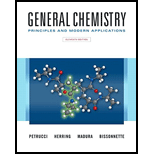
Concept explainers
(a)
Interpretation:
The structure of coordinate complex
Concept introduction:
The coordinate complex is formed by the reaction of metal ions which are electron deficient with ligands which are electron rich. The structure of the coordinate complex is drawn in such a way that metal ion is always placed at the center. The metal ion is than surrounded by ligands which can be negatively charged or neutral. The shape or geometry of the complex can be determined by number of ligands surrounded by a metal ion.
(b)
Interpretation:
The structure of coordinate complex
Concept introduction:
The coordinate complex is formed by the reaction of metal ions which are electron deficient with ligands which are electron rich. The structure of the coordinate complex is drawn in such a way that metal ion is always placed at the center. The metal ion is than surrounded by ligands which can be negatively charged or neutral. The shape or geometry of the complex can be determined by number of ligands surrounded by a metal ion.
(c)
Interpretation:
The structure of coordinate complex
Concept introduction:
The coordinate complex is formed by the reaction of metal ions which are electron deficient with ligands which are electron rich. The structure of the coordinate complex is drawn in such a way that metal ion is always placed at the center. The metal ion is than surrounded by ligands which can be negatively charged or neutral. The shape or geometry of the complex can be determined by number of ligands surrounded by a metal ion.
(d)
Interpretation:
The structure of coordinate complex
Concept introduction:
The coordinate complex is formed by the reaction of metal ions which are electron deficient with ligands which are electron rich. The structure of the coordinate complex is drawn in such a way that metal ion is always placed at the center. The metal ion is than surrounded by ligands which can be negatively charged or neutral. The shape or geometry of the complex can be determined by number of ligands surrounded by a metal ion.
(e)
Interpretation:
The structure of coordinate complex
Concept introduction:
The coordinate complex is formed by the reaction of metal ions which are electron deficient with ligands which are electron rich. The structure of the coordinate complex is drawn in such a way that metal ion is always placed at the center. The metal ion is than surrounded by ligands which can be negatively charged or neutral. The shape or geometry of the complex can be determined by number of ligands surrounded by a metal ion.
Want to see the full answer?
Check out a sample textbook solution
Chapter 24 Solutions
EBK GENERAL CHEMISTRY
- Calculate the pH and the pOH of each of the following solutions at 25 °C for which the substances ionize completely: (a) 0.000259 M HClO4arrow_forwardWhat is the pH of a 1.0 L buffer made with 0.300 mol of HF (Ka = 6.8 × 10⁻⁴) and 0.200 mol of NaF to which 0.160 mol of NaOH were added?arrow_forwardDetermine if the following salt is neutral, acidic or basic. If acidic or basic, write the appropriate equilibrium equation for the acid or base that exists when the salt is dissolved in aqueous solution. If neutral, simply write only NR. Be sure to include the proper phases for all species within the reaction. NaN₃arrow_forward
- A. Draw the structure of each of the following alcohols. Then draw and name the product you would expect to produce by the oxidation of each. a. 4-Methyl-2-heptanol b. 3,4-Dimethyl-1-pentanol c. 4-Ethyl-2-heptanol d. 5,7-Dichloro-3-heptanolarrow_forwardWhat is the pH of a 1.0 L buffer made with 0.300 mol of HF (Ka = 6.8 × 10⁻⁴) and 0.200 mol of NaF to which 0.160 mol of NaOH were added?arrow_forwardCan I please get help with this.arrow_forward
- Determine if the following salt is neutral, acidic or basic. If acidic or basic, write the appropriate equilibrium equation for the acid or base that exists when the salt is dissolved in aqueous solution. If neutral, simply write only NR. Be sure to include the proper phases for all species within the reaction. N₂H₅ClO₄arrow_forwardPlease help me with identifying these.arrow_forwardCan I please get help with this?arrow_forward
 Chemistry: Principles and ReactionsChemistryISBN:9781305079373Author:William L. Masterton, Cecile N. HurleyPublisher:Cengage Learning
Chemistry: Principles and ReactionsChemistryISBN:9781305079373Author:William L. Masterton, Cecile N. HurleyPublisher:Cengage Learning
